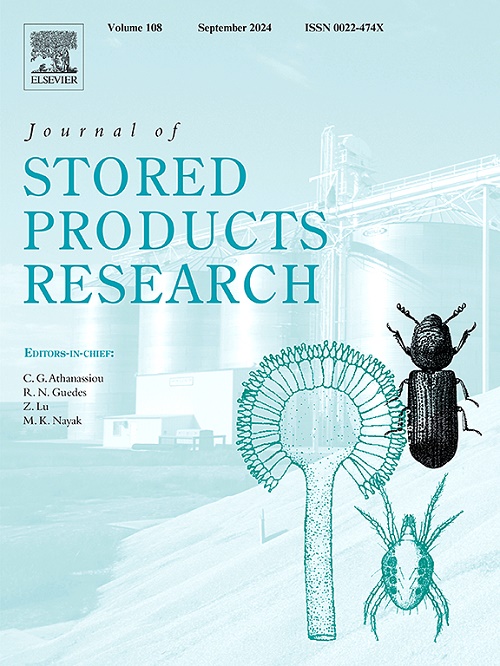玉米象鼻虫Sitophilus zeamais, Motschulsky 1855(鞘翅目:Curculionidae)的颗粒类型影响肠道细菌群落的聚集并产生适应度成本
IF 2.7
2区 农林科学
Q1 ENTOMOLOGY
引用次数: 0
摘要
玉米象甲(Sitophilus zeamais)是世界上储粮中危害最大的昆虫。据报道,在其他昆虫物种中,饮食经常影响它们肠道微生物群的聚集。在这项研究中,我们以玉米、小麦和大麦为食,饲养玉米玉米球菌。我们评估了其对肠道细菌群落聚集和成虫象鼻虫种群特征的影响。我们观察到玉米籽粒的细菌群落结构与大麦和小麦籽粒不同,玉米籽粒的细菌群落结构(以几丁食菌属、副球菌属、棘球杆菌属、不动杆菌属和布鲁氏菌属为主),大麦和小麦籽粒的细菌群落结构均以葡萄糖杆菌属、乳酸菌属和立克次体属为主。我们还发现,根据颗粒类型,分类群显著丰富。在玉米中,我们发现了不动杆菌和单胞菌的富集;在小麦中,我们检测到葡萄糖杆菌、Cetobacterium和Chroococcidiopsus,而在大麦中,我们只检测到葡萄球菌的富集。在玉米上饲养的象鼻虫亲本寿命和产卵时间较长,后代的体重和体型也较大。相比之下,小麦和大麦的后代更大,性别比例倾向于产生更多的雄性,但明显更小、更轻。这些结果背后的原因,深入讨论了可能的生态相关因素,如籽粒的承载能力,种子的叶共生内生菌的假定作用,以及每种饮食类型的营养差异。本文章由计算机程序翻译,如有差异,请以英文原文为准。

Grain type influences the assembly of the intestinal bacterial community and generates a fitness cost in the maize weevil, Sitophilus zeamais, Motschulsky 1855 (Coleoptera: Curculionidae)
The maize weevil (Sitophilus zeamais) is the most pestiferous insect of stored grains worldwide. In other insect species, it has been reported that diet often influences the assembly of their gut microbiota. In this work, we reared S. zeamais on maize, wheat, and barley grains. We evaluated its impact on the assembly of bacterial communities in the gut and some population traits in adult weevils. We observe that the structure of the bacterial community in maize grains (with dominance of Chitinophaga, Paracoccus, Sphingobacterium, Acinetobacter, and Brucella) differed from that of barley and wheat grains, which shared dominance of the genera Gluconobacter, Cetobacterium, and Rickettsia. We also found a significant enrichment of taxa depending on the grain type. In maize, we found an enrichment of Acinetobacter and Comamonas; in wheat, we detected Gluconobacter, Cetobacterium, and Chroococcidiopsus, while in barley, we only detected the enrichment of Staphylococcus. Weevils raised on maize had a higher parental longevity and oviposition time, as well as higher offspring weight and size. In contrast, wheat and barley promoted a larger offspring, with a sex ratio biased toward producing more males, but significantly smaller and lighter. The reasons behind these results are thoroughly discussed in terms of probably ecologically relevant factors such as the carrying capacity of the grains, the putative role of phyllosymbiotic endophytes of the seeds, and the nutritional differences in each diet type.
求助全文
通过发布文献求助,成功后即可免费获取论文全文。
去求助
来源期刊
CiteScore
5.70
自引率
18.50%
发文量
112
审稿时长
45 days
期刊介绍:
The Journal of Stored Products Research provides an international medium for the publication of both reviews and original results from laboratory and field studies on the preservation and safety of stored products, notably food stocks, covering storage-related problems from the producer through the supply chain to the consumer. Stored products are characterised by having relatively low moisture content and include raw and semi-processed foods, animal feedstuffs, and a range of other durable items, including materials such as clothing or museum artefacts.

 求助内容:
求助内容: 应助结果提醒方式:
应助结果提醒方式:


